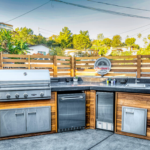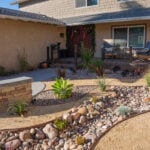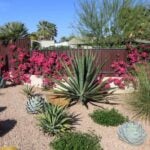Terracing Brilliance
When it comes to front yard landscaping, a house that is slightly drenched in the ground or nestled below grade presents an alternate arrangement of conceivable outcomes and obstructions. Although there could be a few difficulties with the plan, it likewise offers a fresh start to make an extremely exceptional and wonderful outdoor region. This blog post will examine a few imaginative and helpful front yard landscaping ideas that might be utilized to make a welcoming and eye-catching setting on the outside of below-grade homes.
Embracing the Slope
The natural slope of the ground is one of the unique features that distinguish a house below grade. To create a beautiful and seamless transition between the architecture and the surrounding landscape, embrace this element instead of battling against it. To create many levels that follow the slope and accommodate different landscaping items, think about terracing the front yard.
In addition to being more visually pleasing, terraced gardens likewise have utilitarian purposes including preventing soil erosion. Define each patio with retaining walls, planter, and steps; next, select a scope of plants that do well in the different microclimates that the shifted elevations produce.
Grand Entrance
With clever planting, a below-grade house’s entry may be elevated to an amazing level. Create a compelling walkway that leads up to the front entrance, with lovely flowers, a plethora of plants, and perhaps even some water features on each side. Throughout the route, use accent lighting to guide visitors and highlight important elements to create a warm, inviting atmosphere at night.
For added flair, think of adorning entryways, adding apertures, or adding pergolas to the structure to approach the doorway. A well-planned entryway sets the tone for the entire house and enhances its exquisite appeal.
Play with Texture and Color
Given the unique topography, houses below grade provide an opportunity to play with different textures and colors in landscaping. Opt for a diverse selection of plants with varying foliage, flowers, and shapes to add visual interest. Mix and match ground covers, shrubs, and trees to create a layered and dynamic frontyard.
Benefit from the surrounding area’s natural color palette to your advantage by using it in your design. Muted colors, earthy tones, and greens may all work well together to provide a coherent and aesthetically beautiful landscape by blending in with the home and the surrounding environment.
Water Features and Ponds:
Integrating water features for ponds into the frontyard landscaping can be a transformative element for houses below grade. Think about designing a peaceful pond or a tumbling cascade that accentuates the land’s slope. These elements create a calm ambiance by introducing calming noises in addition to visual appeal.
Select aquatic plants and other items that do well in a pond setting. To improve the natural look and create a sense of continuity between the surrounding nature and the water feature, include stones and pebbles. A well-planned pond may become the center of attention and add to the front yard’s overall charm.
Strategic Lighting
Effective lighting can significantly enhance the allure of a frontyard, especially for houses below grade. To draw attention to important features, paths, and architectural details, use a mix of ambient, task, and accent lighting. Light up trees, plants, and other landscape elements at night to create a mystical and welcoming ambiance.
For simplicity of installation and energy efficiency, think about solar-powered lighting. To identify the different levels and terraces, path lights, uplights, and string lights may be carefully arranged to create an eye-catching visual spectacle. In addition to increasing the outdoor area’s usefulness, lighting enhances the landscape’s natural attractiveness.
Utilize Vertical Space
With limited horizontal space, houses below grade can benefit greatly from utilizing vertical space for landscaping. Trellises, climbing plants, and vertical gardens are useful ways to add greenery and visual appeal without taking up valuable ground area. To encourage the growth of vines and other climbing plants, think about building trellises up against retaining walls or the house itself.
In addition to making the most of available space, vertical pieces give the impression of verticality, which draws the eye upward and highlights the house’s distinctive architectural features. Use a range of plants with various growth patterns to give the vertical landscape more depth and variation.
Outdoor Living Spaces
Re-purposing the front yard of a below-grade residence into an outdoor living space can improve the building’s function and aesthetic appeal. Make use of the slant’s inherent orientation by creating welcoming decks, porches, or sitting areas. To ensure a smooth integration with the general landscape, designate these areas with retaining walls or terraces.
Make sure the outdoor design and furnishings complement the area and the design of the property. Use shade-producing structures to shield yourself from the sun, such as umbrellas or pergolas. An outdoor living area not only expands the amount of space that can be utilized for a living. It also serves as a hub for people to congregate and enjoy nature.
Drought-Tolerant and Low-Maintenance Plants:
Choosing low-maintenance and drought-tolerant plants is a sensible strategy for front yard landscaping for homes that are below grade. These low-maintenance plants require little watering and are well-adapted to the difficult circumstances that are frequently seen in sloping settings. Think about native plants that enhance biodiversity and ecological sustainability by adapting to the local environment.
To cover vast areas and stop soil erosion, use ground coverings like succulents or creeping thyme. Include ornamental grasses; they are robust in a range of soil conditions and offer visual appeal. You may design an attractive and sustainable front yard. Furthermore, that accentuates the house’s inherent beauty by selecting plants that require little maintenance.
Hardscaping and Retaining Walls:
Hardscaping elements such as stone walls, pathways, and retaining walls play a crucial role in frontyard landscaping for houses below grade. Along with controlling soil erosion, retaining walls provide level surfaces for landscaping elements like planting. Pick supplies that blend nicely with the surrounding natural environment and the house’s architectural style.
Moreover, to add more sitting and defined spaces, construct seating walls along terraced sections. To give the environment texture and visual appeal, lay walkways made of gravel or stone pavers. Hardscaping features may enhance the front yard’s overall attractiveness and usefulness by serving both practical and decorative purposes.
Hardscaping Wonders
A house below grade requires careful planning to accommodate the special topographical and architectural difficulties while landscaping the front yard. Furthermore, by mixing layered gardens, water highlights, planned lighting, and a combination of textures and varieties, you can establish a beautiful environment. Also, that upgrades the engaging quality of the house and its surroundings. Therefore, a visually pleasing and sustainable front yard might be accomplished. It can be done by adding outdoor living areas, making utilization of vertical space, and selecting drought-resistant plants. Homes below grade might have front yards that are visually pleasing as well as valuable and mix in well with the surrounding environment with smart planning and imaginative plans.






